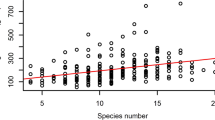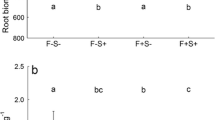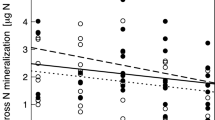Abstract
Plant diversity is an important driver of nitrogen and phosphorus stocks in aboveground plant biomass of grassland ecosystems, but plant diversity effects on other elements also important for plant growth are less understood. We tested whether plant species richness, functional group richness or the presence/absence of particular plant functional groups influences the Si and Ca concentrations (mmol g−1) and stocks (mmol m−2) in aboveground plant biomass in a large grassland biodiversity experiment (Jena Experiment). In the experiment including 60 temperate grassland species, plant diversity was manipulated as sown species richness (1, 2, 4, 8, 16) and richness and identity of plant functional groups (1–4; grasses, small herbs, tall herbs, legumes). We found positive species richness effects on Si as well as Ca stocks that were attributable to increased biomass production. The presence of particular functional groups was the most important factor explaining variation in aboveground Si and Ca stocks (mmol m−2). Grass presence increased the Si stocks by 140 % and legume presence increased the Ca stock by 230 %. Both the presence of specific plant functional groups and species diversity altered Si and Ca stocks, whereas Si and Ca concentration were affected mostly by the presence of specific plant functional groups. However, we found a negative effect of species diversity on Si and Ca accumulation, by calculating the deviation between mixtures and mixture biomass proportions, but in monoculture concentrations. These changes may in turn affect ecosystem processes such as plant litter decomposition and nutrient cycling in grasslands.



Similar content being viewed by others
References
Abbas M, Ebeling A, Oelmann Y, Ptacnik R, Roscher C, Weigelt A, Weisser WW, Wilcke W, Hillebrand H (2013) Biodiversity effects on plant stoichiometry. PLoS ONE 8:e58179. doi:10.51371/journal.pone.0058179
Andrew C, Johnson A (1976) Effect of calcium, pH and nitrogen on the growth and chemical composition of some tropical and temperate pasture legumes. II.* Chemical composition (calcium, nitrogen, potassium, magnesium, sodium and phosphorus). Crop and Past Sci 27:625–636
Balvanera P, Pfisterer AB, Buchmann N, He JS, Nakashizuka T, Raffaelli D, Schmid B (2006) Quantifying the evidence for biodiversity effects on ecosystem functioning and services. Ecol Lett 9:1146–1156
Bates D, Sakar D (2006) LME 4: linear mixed-effects models using S4 classes. R package version 0.995–2. http://www.r-project.org/
Bauer P, Elbaum R, Weiss IM (2011) Calcium and silicon mineralization in land plants: transport, structure and function. Plant Sci 180:746–756
Beßler H, Oelmann Y, Roscher C, Buchmann N, Scherer-Lorenzen M, Schulze ED, Temperton VM, Wilcke W, Engels C (2012) Nitrogen uptake by grassland communities: contribution of N2 fixation, facilitation, complementarity, and species dominance. Plant Soil 358:301–322
Blinnikov MS, Bagent CM, Reyerson PE (2013) Phytolith assemblages and opal concentrations from modern soils differentiate temperate grasslands of controlled composition on experimental plots at Cedar Creek, Minnesota. Quat Int 287:101–113
Brackhage C, Schaller J, Bäucker E, Dudel EG (2013) Silicon availability affects the stoichiometry and content of calcium and micro nutrients in the leaves of Common Reed. Silicon 5:199–204
Broadley MR, Bowen HC, Cotterill HL, Hammond JP, Meacham MC, Mead A, White PJ (2003) Variation in the shoot calcium content of angiosperms. J Exp Bot 54:1431–1446
Broadley MR, Bowen HC, Cotterill HL, Hammond JP, Meacham MC, Mead A, White PJ (2004) Phylogenetic variation in the shoot mineral concentration of angiosperms. J Exp Bot 55:321–336
Broadley M, Brown P, Cakmak I, Ma JF, Rengel Z, Zhao F (2012) Chapter 8-beneficial elements. In: Marschner P (ed) Marschner’s mineral nutrition of higher plants, 3rd edn. Academic Press, San Diego, pp 249–269
Cardinale BJ, Srivastava DS, Duffy JE, Wright JP, Downing AL, Sankaran M, Jouseau C (2006) Effects of biodiversity on the functioning of trophic groups and ecosystems. Nature 443:989–992
Cooke J, Leishman MR (2011a) Is plant ecology more siliceous than we realise? Trends Plant Sci 16:61–68
Cooke J, Leishman MR (2011b) Silicon concentration and leaf longevity: is silicon a player in the leaf dry mass spectrum? Funct Ecol 25:1181–1188
Cornelis JT, Delvaux B, Cardinal D, Andre L, Ranger J, Opfergelt S (2010) Tracing mechanisms controlling the release of dissolved silicon in forest soil solutions using Si isotopes and Ge/Si ratios. Geochim Cosmochim Acta 74:3913–3924
Currie HA, Perry CC (2007) Silica in plants: biological, biochemical and chemical studies. Ann Bot 100:1383–1389
Dixit S, Van Cappellen P (2002) Surface chemistry and reactivity of biogenic silica. Geochim Cosmochim Acta 66:2559–2568
Ehrlich H, Demadis KD, Pokrovsky OS, Koutsoukos PG (2010) Modern views on desilicification: biosilica and abiotic silica dissolution in natural and artificial environments. Chem Rev 110:4656–4689
Ellenberg H (1988) Vegetation ecology of Central Europe. Cambridge University Press, Cambridge
Epstein E (1994) The anomaly of silicon in plant biology. Proc Natl Acad Sci USA 91:11–17
Epstein E (1999) Silicon. Annu Rev Plant Physiol Plant Mol Biol 50:641–664
Fraysse F, Pokrovsky OS, Schott J, Meunier JD (2009) Surface chemistry and reactivity of plant phytoliths in aqueous solutions. Chem Geol 258:197–206
Han WX, Fang JY, Reich PB, Woodward FI, Wang ZH (2011) Biogeography and variability of eleven mineral elements in plant leaves across gradients of climate, soil and plant functional type in China. Ecol Lett 14:788–796
Hodson MJ, Sangster AG (1988) Observations on the distribution of mineral elements in the leaf of wheat (Triticum aestivum L.), with particular reference to silicon. Ann Bot 62:463–471
Hooper DU (1998) The role of complementarity and competition in ecosystem responses to variation in plant diversity. Ecology 79:704–719
Jakobsen ST (1993) Interaction between plant nutrients: IV. Interaction between calcium and phosphate. Acta Agric Scand Sect B-Soil Plant Sci 43:6–10
Karanika ED, Alifragis DA, Mamolos AP, Veresoglou DS (2007) Differentiation between responses of primary productivity and phosphorus exploitation to species richness. Plant Soil 297:69–81
Kluge G, Müller-Westermeier G (2000) Das Klima ausgewählter Orte der Bundesrepublik Deutschland: Jena. Berichte des Deutschen Wetterdienstes 213. Offenbach
Larcher W (2003) Physiological plant ecology: ecophysiology and stress physiology of functional groups. Springer, Berlin
Leimer S, Oelmann Y, Wirth C, Wilcke W (2015) Time matters for plant diversity effects on nitrate leaching from temperate grassland. Agri Eco Env 211:155–163
Loranger H, Weisser WW, Ebeling A, Eggers T, De Luca E, Loranger J, Roscher C, Meyer ST (2014) Invertebrate herbivory increases along an experimental gradient of grassland plant diversity. Oecologia 174:183–193
Lucas Y (2001) The role of plants in controlling rates and products of weathering: importance of biological pumping. Annu Rev Earth Planet Sci 29:135–163
Ma JF, Yamaji N (2006) Silicon uptake and accumulation in higher plants. Trends Plant Sci 11:392–397
Makabe S, Kakuda KI, Sasaki Y, Ando T, Fujii H, Ando H (2009) Relationship between mineral composition or soil texture and available silicon in alluvial paddy soils on the Shounai Plain. Japan Soil Sci Plant Nutr 55:300–308
Marquard E, Weigelt A, Temperton VM, Roscher C, Schumacher J, Buchmann N, Fischer M, Weisser WW, Schmid B (2009) Plant species richness and functional composition drive overyielding in a six-year grassland experiment. Ecology 90:3290–3302
Marschner H (2003) Mineral nutrition of higher plants. Academic Press, London
Massey FP, Ennos AR, Hartley SE (2006) Silica in grasses as a defence against insect herbivores: contrasting effects on folivores and a phloem feeder. J Anim Ecol 75:595–603
Melzer SE, Knapp AK, Kirkman KP, Smith MD, Blair JM, Kelly EF (2010) Fire and grazing impacts on silica production and storage in grass dominated ecosystems. Biogeochemistry 97:263–278
Mueller KE, Hobbie SE, Tilman D, Reich PB (2013) Effects of plant diversity, N fertilization, and elevated carbon dioxide on grassland soil N cycling in a long-term experiment. Glob Change Biol 19:1249–1261
Oelmann Y, Kreutziger Y, Temperton VM, Buchmann N, Roscher C, Schumacher J, Schulze ED, Weisser WW, Wilcke W (2007) Nitrogen and phosphorus budgets in experimental grasslands of variable diversity. J Environ Qual 36:396–407
Oelmann Y, Buchmann N, Gleixner G, Habekost M, Roscher C, Rosenkranz S, Schulze ED, Steinbeiss S, Temperton VM, Weigelt A (2011a) Plant diversity effects on aboveground and belowground N pools in temperate grassland ecosystems: development in the first 5 years after establishment. Glob Biogeochem Cycle. doi:10.1029/2010GB003869
Oelmann Y, Richter AK, Roscher C, Rosenkranz S, Temperton VM, Weisser WW, Wilcke W (2011b) Does plant diversity influence phosphorus cycling in experimental grasslands? Geoderma 167–68:178–187
R-Development-Core-Team (2012) R: A language and environment for statistical computing. R Foundation for Statistical Computing, Vienna, Austria. ISBN 3-900051-07-0. http://www.R-project.org/, http://www.rstudio.com/
Robson A, Edwards D, Loneragan J (1970) Calcium stimulation of phosphate absorption by annual legumes. Crop Past Sci 21:601–612
Roscher C, Schumacher J, Baade J, Wilcke W, Gleixner G, Weisser WW, Schmid B, Schulze E-D (2004) The role of biodiversity for element cycling and trophic interactions: an experimental approach in a grassland community. Basic Appl Ecol 5:107–121
Roscher C, Thein S, Schmid B, Scherer-Lorenzen M (2008) Complementary nitrogen use among potentially dominant species in a biodiversity experiment varies between two years. J Ecol 96:477–488
Schaller J, Struyf E (2013) Silicon controls microbial decay and nutrient release of grass litter during aquatic decomposition. Hydrobiologia 709:201–212
Schaller J, Brackhage C, Gessner MO, Bäuker E, Dudel EG (2012) Silicon supply modifies C: N: P stoichiometry and growth of Phragmites australis. Plant Biol 14:392–396
Schaller J, Brackhage C, Paasch S, Brunner E, Bäucker E, Dudel EG (2013) Silica uptake from nanoparticles and silica condensation state in different tissues of Phragmites australis. Sci Total Environ 442:6–9
Schaller J, Hines J, Brackhage C, Bäucker E, Gessner MO (2014) Silica decouples fungal growth and litter decomposition without changing responses to climate warming and N enrichment. Ecology 95:3181–3189
Schoelynck J, Bal K, Backx H, Okruszko T, Meire P, Struyf E (2010) Silica uptake in aquatic and wetland macrophytes: a strategic choice between silica, lignin and cellulose? New Phytol 186:385–391
Schoelynck J, Müller F, Vandevenne F, Bal K, Barão L, Smis A, Opdekamp W, Meire P, Struyf E (2014) Silicon–vegetation interaction in multiple ecosystems: a review. J Veg Sci 25:301–313
Sommer M, Kaczorek D, Kuzyakov Y, Breuer J (2006) Silicon pools and fluxes in soils and landscapes––a review. J Plant Nutr Soil Sci-Z Pflanzenernahr Bodenkd 169:310–329
Song Z, Liu H, Zhao F, Xu C (2014) Ecological stoichiometry of N:P: Si in China’s grasslands. Plant Soil 380:165–179
Spehn E, Scherer-Lorenzen M, Schmid B, Hector A, Caldeira M, Dimitrakopoulos P, Finn J, Jumpponen A, O’donnovan G, Pereira J (2002) The role of legumes as a component of biodiversity in a cross-European study of grassland biomass nitrogen. Oikos 98:205–218
Struyf E, Conley DJ (2009) Silica: an essential nutrient in wetland biogeochemistry. Front Ecol Environ 7:88–94
Taber HG, Shogren D, Lu G (2002) Extraction of silicon from plant tissue with dilute HCl and HF and measurement by modified inductive coupled argon plasma procedures. Commun Soil Sci Plant Anal 33:1661–1670
Vandevenne F, Struyf E, Clymans W, Meire P (2012) Agricultural silica harvest: have humans created a new loop in the global silica cycle? Front Ecol Environ 10:243–248
Weigelt A, Marquard E, Temperton VM, Roscher C, Scherber C, Mwangi PN, Felten S, Buchmann N, Schmid B, Schulze ED (2010) The Jena Experiment: six years of data from a grassland biodiversity experiment: ecological Archives E091-066. Ecology 91:930–931
White AF, Vivit DV, Schulz MS, Bullen TD, Evett RR, Aagarwal J (2012) Biogenic and pedogenic controls on Si distributions and cycling in grasslands of the Santa Cruz soil chronosequence, California. Geochim Cosmochim Acta 94:72–94
Acknowledgments
We thank the many people who helped with the management of the experiment, especially the gardeners and many student helpers. Thanks are also due to all the helpers during the weeding campaigns. The Jena Experiment is funded by the Deutsche Forschungsgemeinschaft (DFG, Wi 1601/4-1,-2, FOR 456/1451), with additional support from the Friedrich Schiller University of Jena and the Max Planck Society. The authors are grateful to Ms. G. Ciesielski and Mr. A. Weiske (both TU Dresden) for laboratory assistance and Si measurements.
Author contribution statement
J.S., C.R., H.H., A.W., Y.O., W. Wilcke, A.E., and W. Weisser designed the study and carried out the measurements. J.S. analyzed the data and wrote the first draft of the manuscript. All authors contributed to the writing of the manuscript.
Author information
Authors and Affiliations
Corresponding author
Additional information
Communicated by Hermann Heilmeier.
Electronic supplementary material
Below is the link to the electronic supplementary material.
Rights and permissions
About this article
Cite this article
Schaller, J., Roscher, C., Hillebrand, H. et al. Plant diversity and functional groups affect Si and Ca pools in aboveground biomass of grassland systems. Oecologia 182, 277–286 (2016). https://doi.org/10.1007/s00442-016-3647-9
Received:
Accepted:
Published:
Issue Date:
DOI: https://doi.org/10.1007/s00442-016-3647-9




